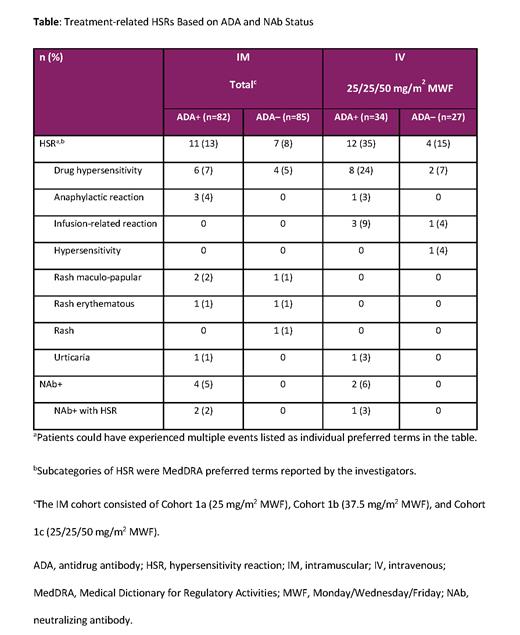Introduction: L-asparaginase is important in multi-agent treatment regimens for pediatric and adult patients (pts) with ALL/LBL. However, hypersensitivity reactions (HSRs) to E. coli-derived asparaginases (ASP) often lead to treatment delay or discontinuation. JZP458, a recombinant Erwinia ASP derived from a Pseudomonas fluorescens expression platform, is indicated as part of multi-agent chemotherapy regimens for ALL/LBL in adult and pediatric pts ≥1 month old who developed HSRs to E. coli-derived ASP. Here we report the immunogenicity profile of JZP458 based on study AALL1931.
Methods: AALL1931 was an open-label, 2-part, multicenter, phase 2/3 trial conducted with the Children's Oncology Group to investigate efficacy, safety, and pharmacokinetics (PK) of JZP458 in ALL/LBL (NCT04145531). Eligible pediatric and adult pts with ALL/LBL who developed HSRs (grade ≥3 allergic reaction or silent inactivation) to E. coli-derived ASP received JZP458 as part of their multi-agent treatment regimen. Each dose of E. coli-derived pegaspargase was substituted with 6 doses of JZP458 either intramuscularly (IM, Part A) or intravenously (IV, Part B) on Mon/Wed/Fri over 2 weeks, defined as 1 course. Efficacy endpoints were the proportion of pts maintaining therapeutic nadir serum ASP activity (SAA) ≥0.1 IU/mL at the last 72-hour (primary endpoint) or 48-hour (key secondary endpoint) time point during course 1. Other endpoints included safety and tolerability, PK, and antidrug antibody (ADA) formation.
Immunogenicity samples were collected prior to dose 1 in each course, prior to dose 6 in course 1, and at end-of-study safety follow-up visit (30±3 days after last dose). For pts experiencing HSRs, additional samples were tested for ADAs. A multi-tiered approach was used to measure ADAs and neutralizing antibodies (NAbs) to evaluate immunogenicity of JZP458. First, samples were screened for ADAs that bind JZP458. Samples with potentially ADA-positive (+) results were retested for binding specificity confirmation. Samples confirmed as ADA+ were tested further for NAbs. For pts with ADA+ samples obtained prior to study end, follow-up ADA samples up to approximately 6 months after the last dose of the last course were collected. The ADA assay was a validated binding assay based on an electro-chemiluminescence immunosorbent assay technique and the NAb assay was a validated enzymatic activity assay.
Results: The median (range) age of pts was 10 (1-25) years. Analysis of pts receiving IM JZP458 (n=167) showed that 82 (49%) pts had confirmed ADA toward JZP458; of these, 7 (4%) were ADA+ at pre-dose 1. Twenty-two pts (15% of 146 pts with samples) remained ADA+ at the end of study. Overall, 18 (11%) pts developed treatment-related HSRs after receiving IM JZP458. Among ADA+ pts (n=82), 11 (13%) experienced treatment-related HSR and 4 (5%) developed positive NAbs. Of ADA-negative (-) pts, 7/85 (8%) experienced treatment-related HSRs.
Among pts receiving IV JZP458 (n=61), 34 (56%) had confirmed ADA toward JZP458; of these, 1 (2%) was ADA+ at pre-dose 1. Seventeen pts (34% of 50 pts with samples) remained ADA+ at the end of study. Overall, 16 (26%) pts developed treatment-related HSRs after receiving IV JZP458. Among ADA+ pts (n=34), 12 (35%) experienced treatment-related HSRs and 2 (6%) developed positive NAbs. Of ADA- pts, 4/27 (15%) experienced treatment-related HSRs. Anti-JZP458 antibody status was evaluated as a potential covariate for PK of IM or IV JZP458 within the population PK analysis and it was not found to be a significant covariate. SAA levels were similar between ADA+ and ADA- pts. Overall treatment-related adverse events (TRAEs) in ADA+ and ADA- pts were similar and consistent with the most common TRAEs expected with ASP-containing chemotherapy for ALL (Table). TRAEs led to JZP458 discontinuation for 14 pts with ADA+ status in Part A (8%) and 13 in Part B (21%).
Conclusions: The majority of pts who developed ADAs did not develop HSRs or NAbs. The overall rate of HSRs was similar to literature-reported rates for ASP and appeared to be higher with IV vs IM JZP458. ADA status did not appear to impact PK and other AEs for JZP458. Based on these results, no specific immunological concerns were identified with JZP458 beyond known immunogenicity risks associated with ASP and no specific clinical decisions are recommended based on immunogenicity testing.
OffLabel Disclosure:
Maese:Jazz Pharmaceuticals: Consultancy, Speakers Bureau. Choi:Jazz Pharmaceuticals: Current holder of stock options in a privately-held company, Ended employment in the past 24 months. Liang:Jazz Pharmaceuticals: Current Employment, Current holder of stock options in a privately-held company. Aoki:Jazz Pharmaceuticals: Current Employment, Current holder of stock options in a privately-held company. Roller:Jazz Pharmaceuticals: Current Employment, Current holder of stock options in a privately-held company. Lin:Jazz Pharmaceuticals: Current holder of stock options in a privately-held company, Ended employment in the past 24 months. Agarwal:Jazz Pharmaceuticals: Current Employment, Current holder of stock options in a privately-held company. Chandrasekaran:Jazz Pharmaceuticals: Current Employment, Current holder of stock options in a privately-held company. Iannone:Jazz Pharmaceuticals: Current Employment, Current holder of stock options in a privately-held company. Silverman:Jazz Pharmaceuticals: Membership on an entity's Board of Directors or advisory committees; Servier Pharmaceuticals: Membership on an entity's Board of Directors or advisory committees. Raetz:Bristol Myers Squibb: Membership on an entity's Board of Directors or advisory committees; Pfizer: Research Funding. Rau:Servier Pharmaceuticals: Membership on an entity's Board of Directors or advisory committees; Jazz Pharmaceuticals: Membership on an entity's Board of Directors or advisory committees.
JZP458 (asparaginase erwinia chrysanthemi [recombinant]-rywn) is a recombinant Erwinia asparaginase derived from a novel expression platform. It is used in treatment of patients with acute lymphoblastic leukemia/lymphoblastic lymphoma who developed hypersensitivity/silent inactivation to Escherichia coli-derived asparaginases.


This feature is available to Subscribers Only
Sign In or Create an Account Close Modal